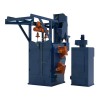
The company was launched in 2004 by James Lemke, a self-described "serial entrepreneur," with an initial investment from John Walton, son of Wal-Mart founder Sam. based in San Diego. Achates earlier this year opened an engineering center in Farmington Hills.
The U.S. Department of Energy made a $9 million grant to Achates, Delphi Automotive and Argonne National Laboratory. Together the three recipients will invest another $4 million to develop a 3-cylinder, 3-liter opposed-piston gasoline compression engine that could improve fuel efficiency by 50% or more on large passenger vans, pickup trucks, SUVs and minivans.
So what is an opposed-piston engine and how does it work ?
Instead of one piston per cylinder, which requires four cycles per firing, opposed-pistons engines have two pistons per cylinder, both connected by levers with a single crankshaft. With two pistons per cylinder, working in opposite reciprocating action, there's no need for cylinder heads, which means less heat is lost in the combustion process.
The advantage is the engine can produce equal performance for less displacement and less emissions from pressure inside the cylinder than a four-stroke engine. Combined with gasoline compression injection there is an opportunity improve fuel economy significantly and reduce emissions of nitrous oxides and particulate matter.
The 30-month program will draw on Achates' expertise, Delphi's experience with gasoline compression injection systems and Argonne's know-how on single-cylinder engines.
This opens new technical and commercial territory for the 11-year-old company.
"Most of our work to date has been with diesels and some natural gas engine, and those tend to be larger engines aimed at large commercial vehicles," said Larry Fromm, Achates vice president for business and strategy development. "This project involves engines for passenger vehicles such as shuttle vans, pickup trucks, minivans and SUVs."
So why haven't automakers and truck manufacturers already beaten a path to Achates' door?
The short answer is that most of its work so far has been focused on research and development. This is the company's third joint development program.
Earlier this year Achates received a $14 million for development on a new generation of engines to power future combat and tactical vehicles for the Army in partnership with Cummins, the engine-making giant.
In 2013 Fairbanks Morse Engine, a manufacturer of industrial and marine engines, and Achates began work to reduce emissions and fuel consumption of Fairbanks Morse proprietary diesel and dual-fuel opposed-piston engines.
While Volkswagen's emission-cheating scandal, not to mention falling gas prices, may reinforce American car buyers' reluctance to give diesels a chance, the commercial trucking industry is the likely initial market for this technology.
The project with Delphi and Argonne is important because it could lead to sales in the light-vehicle market. The end product will not be a diesel, but a 3-liter gasoline compression ignition engine.
"GCI provides diesel-like efficiency in a gasoline engine, without typical diesel and after-treatment cost penalties," said Achates CEO David Johnson.
In 2012, the National Highway Safety Administration determined that by model year 2021, each manufacturer will need to achieve a combined fleet-average fuel economy of between 40.3 and 41 miles per gallon. Not long ago, industry observers expected hybrids and electric vehicles to drive compliance with those targets.
But with gas prices trending toward $2 a gallon or lower in much of the country that premise is shaky. Even the Energy Information Administration, an arm of the Energy Department, projects that in 2035 about 95% of light vehicles will still be powered by internal combustion engines.
Fromm and Fabien Redon, Achates vice president of technology development, said company's existing work force of 85 people will handle most of the new program's work, which will be divided between San Diego and Farmington Hills.
"But we will probably hire some contractor-supported work," Redon said.
While the privately-held company doesn't disclose financial results, it has attracted about $100 million in venture capital from investors who are willing to stick it out for the long term.
"You do need patient investors, but we are making great progress in terms of technology development and customer traction," said Fromm. "We are working with clients in India, Japan, China, Europe and the U.S."





